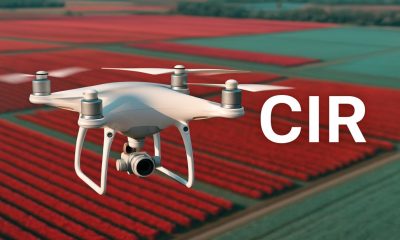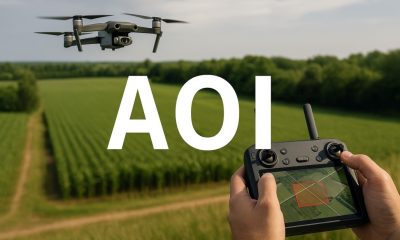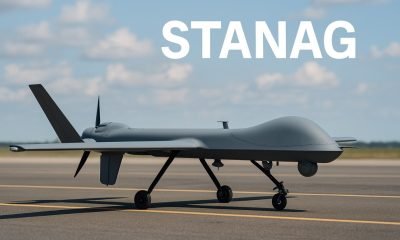- Guide
- Top Innovators
- Adam Bry – Skydio
- Abe Bachrach – Skydio
- Arthur Erickson – Hylio
- Blake Resnick – BRINC
- Brandon Basso – 3d robotics
- Chris Anderson – 3D Robotics
- Ian Laffey – Theseus
- Jordi Muñoz – 3D Robotics
- Lorenz Meier – Auterion
- Keenan Wyrobek – Zipline
- Keller Rinaudo Cliffton – Zipline
- Rich Enderle – Airspace Link
- Robert Dahlstrom – Apellix
- Yariv Bash – Flytrex
Innovators
Chris Anderson, Co-Founder of 3D Robotics – Innovator Series
Published
1 month agoon
By
Jacob StonerTable Of Contents

Chris Anderson, former Editor-in-Chief of Wired magazine, made a bold shift from journalism to technology leadership. As co-founder of 3D Robotics (3DR) and the DIY Drones community, he helped launch some of the most influential open-source projects in the drone world. His support for ArduPilot made advanced aerial systems more accessible to both hobbyists and professionals around the globe.
Academic and Technical Foundations of Chris Anderson
Born in London in 1961, Chris Anderson moved to the United States when he was five. He pursued physics at George Washington University and continued his studies in quantum mechanics and science journalism at the University of California, Berkeley.
His early editorial career included roles at Nature and Science, eventually leading to a seven-year run at The Economist. In 2001, Anderson became Editor-in-Chief of Wired, where he remained until 2012. These experiences sharpened his ability to communicate emerging technology trends and inspired his later ventures in robotics.
Founding and Building 3D Robotics with Chris Anderson
In 2007, Anderson created DIYDrones.com, a community platform for drone enthusiasts. Through this network, he connected with Jordi Muñoz, a self-taught engineer who built an autonomous drone using Wii controllers. Impressed by Muñoz’s ingenuity, Anderson partnered with him to co-found 3D Robotics in 2009.
Their mission was simple yet powerful: make drone hardware and software affordable, open, and community-driven. This vision laid the foundation for ArduPilot, an open-source autopilot system that quickly gained popularity.
Chris Anderson’s Role in ArduPilot and Open-Source Drone Systems
While Jordi Muñoz developed the original ArduPilot software, Chris Anderson played a pivotal role in bringing it to the masses. He advocated for a fully open and community-led development model. As a result, ArduPilot evolved to support multiple platforms, including fixed-wing aircraft, multicopters, boats, and rovers.
Moreover, Anderson’s leadership helped build an ecosystem around ArduPilot. Its flexibility, affordability, and global support base made it one of the most widely adopted autopilot systems in the world.
Milestones Achieved Under Chris Anderson’s Vision
Throughout his time at 3DR, Anderson reached several major milestones:
Expansion of 3DR: The company became one of the leading drone manufacturers in North America. Its flagship product, the Solo drone, was among the first consumer drones with integrated open-source flight control.
Formation of Dronecode: In 2014, Anderson helped launch the Dronecode Consortium under the Linux Foundation. This move formalized collaboration among developers and provided long-term support for key projects like ArduPilot and PX4.
Shift to Software: As the hardware market grew more competitive, 3DR transitioned to focus on enterprise software solutions. This pivot leveraged their strength in open platforms and long-term vision for scalable drone operations.
Thought Leadership and Industry Influence
Beyond drones, Chris Anderson is a respected thought leader in technology and innovation. He authored several best-selling books, including The Long Tail, Free, and Makers: The New Industrial Revolution. These works explored how digital tools empower individuals to build and distribute products at scale.
In the drone industry, his advocacy for open-source tools helped legitimize community-built systems. He frequently spoke about the power of distributed innovation and encouraged companies to embrace collaborative development models.
Chris Anderson’s Vision for the Future of Drone Autonomy
Looking forward, Anderson believes drones will become everyday tools—just as smartphones and laptops are today. He sees their integration into industries like agriculture, energy, infrastructure, and disaster response as inevitable.
To get there, he continues to champion open-source frameworks. These ecosystems accelerate innovation, reduce costs, and ensure adaptability. By supporting a broad developer base, Anderson believes we can create drone technologies that meet a wider range of real-world needs.
Closing Insights
Chris Anderson’s journey—from journalist to tech entrepreneur—underscores how passion and community can drive meaningful change. By making drone technology more accessible and fostering open collaboration, he helped shape one of the most important revolutions in modern robotics.
His impact lives on through ArduPilot, DIY Drones, and the growing ecosystem of developers who continue to build on his vision of open innovation in the sky.
Connect with Chris Anderson
As the CEO of Flyeye.io, Jacob Stoner spearheads the company's operations with his extensive expertise in the drone industry. He is a licensed commercial drone operator in Canada, where he frequently conducts drone inspections. Jacob is a highly respected figure within his local drone community, where he indulges his passion for videography during his leisure time. Above all, Jacob's keen interest lies in the potential societal impact of drone technology advancements.











